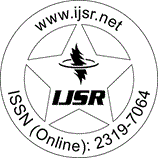Downloads: 132
Research Paper | Radiological Sciences | Iraq | Volume 6 Issue 12, December 2017
Using the (Region of Interest ROI) Option of Magnetic Resonance Imaging (MRI) to Distinguish between Multiple Sclerosis (MS) and Ischemic Plaques in the Central Nervous System (CNS)
Ali Abd Sulaiman | Nabaa A. Naji | Mona Abdul-Ghani Al-Rawi
Abstract: Background Magnetic Resonance Imaging is a device used in neurological examination, ?it uses a combination of a strong magnetic field and radio waves to produce detailed pictures of the inside of the body? and can be used for the diagnosis of MS and Ischemia in brain. Studies of different MRI techniques were done to examine the diagnostic accuracy of MS and Ischemia separately. Some of these techniques depended the quantitative susceptibility mapping which used the T2W and T1W with contrast sequences where their susceptibility values were measured in MS disease, ?while other study of a multi-spectral classification approach compared against mono-spectral classification performance using only FLAIR MRI datasets and two sets of expert segmentations were used for inter-observer agreement evaluation in Ischemia disease?. There is no previous research which use the ROI option of the MRI software to examine the best MRI sequence which provides a signal intensity reader that can distinguish between MS and Ischemia Patients and method This study involved 100 patients who were diagnosed as having brain Ischemia and 76 who have MS. ? Imaging was performed on a 3T Philips MR system using T1W turbo spin echo (T1W_TSE) with and without contrast, ?uid attenuated inversion recovery (FLAIR), and T2W turbo spin echo (T2W_TSE) sequences with the same parameters for both diseases that includes ?eld of view (FOV), image's matrix, slice thickness, voxel size, and number of signal averaging (NSA) ? and reading signal intensity by ROI option in MRI software Result The data of the current research showed that ?there is a significant difference in the signal intensity of the T2W and T2W. FLAIR sequences between Ischemia and MS?. It was found that there was a noticeable significant increase in the signal of (T2Wmin, max, mean) and (T2W. FLAIR min, max, mean) in MS disease as compared with the same values of Ischemia (P< 0.009, 0.001, 0.002) respectively (P< 0.0001). Using the T1Wmin, max, mean sequence with contrast provided a very strong significance in showing the active MS lesions (P< 0.0001). The four MRI sequences efficiency for distinguishing MS lesions from Ischemia were examined and the results analysis by the AUC indicated the priority of T2W. FLAIR in detecting the MS rather than Ischemia (AUC = 0.840). Conclusion T2W. FLAIR sequence is the best for differentiation between MS and Ischemia plaques of the brain where the MRI signal intensity reading was read by the Region of Interest option of the MRI device software. Moreover, TIW with contrast is considered as an excellent indicator for the active MS.
Keywords: MRI, MS, Ischemia, T1W, T2W, FLAIR and T1W with contrast sequences
Edition: Volume 6 Issue 12, December 2017,
Pages: 440 - 446
Similar Articles with Keyword 'MRI'
Downloads: 1 | Weekly Hits: ⮙1 | Monthly Hits: ⮙1
Case Studies, Radiological Sciences, India, Volume 12 Issue 4, April 2023
Pages: 787 - 792Clinico Radiological Correlation of Pediatric and Neonatal Seizures
Dr. Ankur Chandra [3] | Dr. Ashok Uppal | Dr Chapala Shashank
Downloads: 1 | Weekly Hits: ⮙1 | Monthly Hits: ⮙1
Case Studies, Radiological Sciences, India, Volume 12 Issue 6, June 2023
Pages: 1605 - 1607Case Study of Spontaneous Intracranial Hypotension
Lipika Gupta [2] | Archit Gupta [5] | Deepak Varshney
